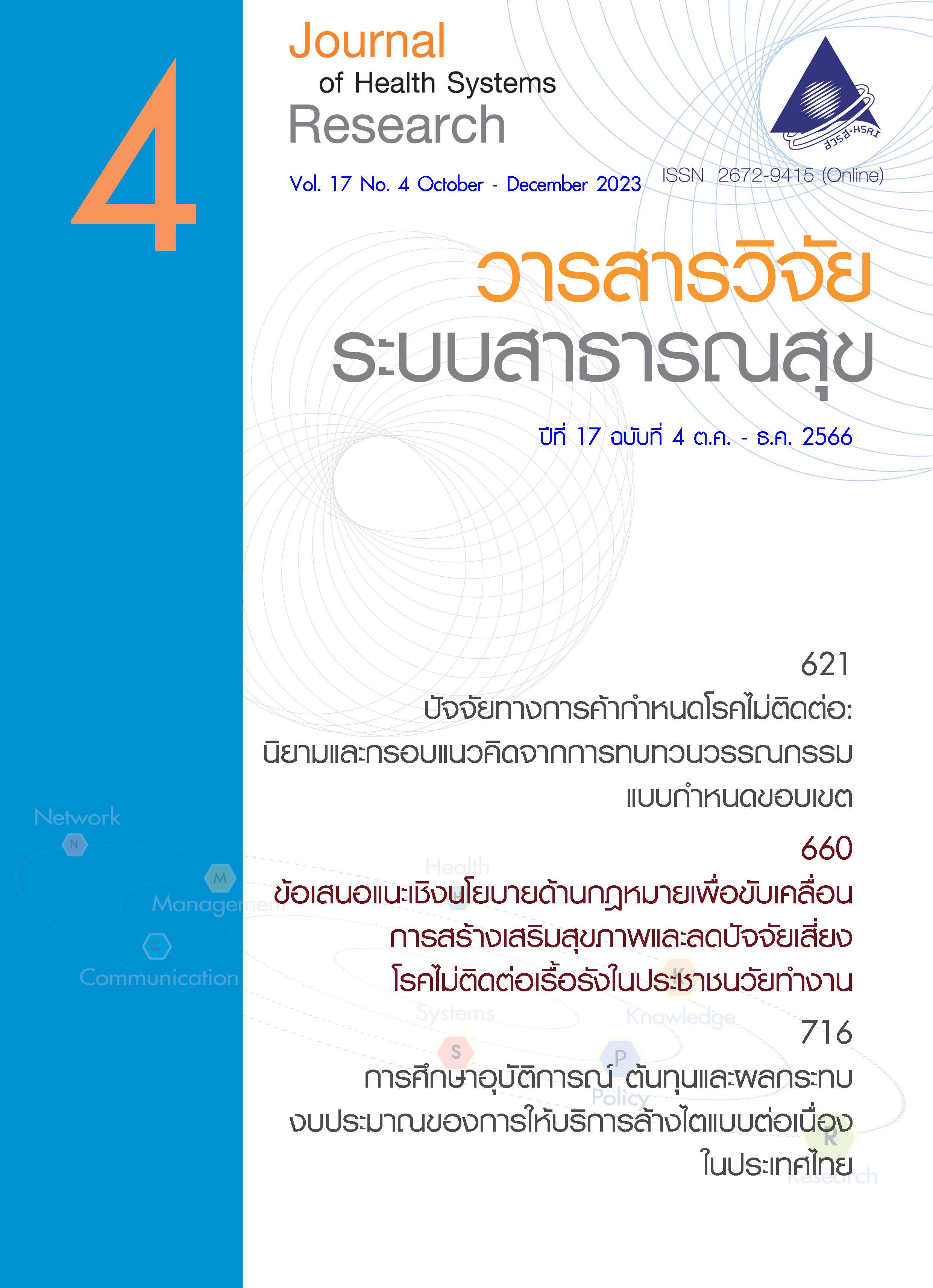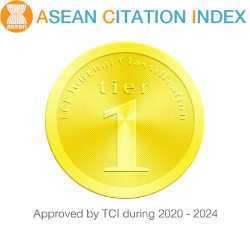ปัจจัยทางการค้ากำหนดโรคไม่ติดต่อ: นิยามและกรอบแนวคิดจากการทบทวนวรรณกรรมแบบกำหนดขอบเขต
คำสำคัญ:
กรอบแนวคิด, ปัจจัยทางการค้ากำหนดสุขภาพ, โรคไม่ติดต่อ, นิยามบทคัดย่อ
การศึกษานี้มีวัตถุประสงค์เพื่อกำหนดขอบเขตเพื่อพัฒนากรอบแนวคิดในการติดตามปัจจัยทางการค้ากำหนดโรคไม่ติดต่อ โดยใช้วิธีการศึกษาเชิงคุณภาพ ด้วยวิธีการทบทวนวรรณกรรมแบบกำหนดขอบเขต (scoping review) การสัมภาษณ์และอภิปรายกลุ่มกับผู้เชี่ยวชาญและผู้เกี่ยวข้องกับกระบวนการนโยบายป้องกันและควบคุมโรคไม่ติดต่อของประเทศไทย
จากการทบทวนวรรณกรรม ผู้วิจัยได้กำหนดนิยามของ “ปัจจัยทางการค้ากำหนดโรคไม่ติดต่อ (commercial determinants of NCDs) หมายถึง กลยุทธ์และการปฏิบัติที่ใช้โดยภาคธุรกิจและอุตสาหกรรมที่เกี่ยวข้องกับปัจจัยเสี่ยงโรคไม่ติดต่อเพื่อผลประโยชน์ทางด้านการค้า การเพิ่มผลกำไร ตลอดจนการรักษาเสถียรภาพทางธุรกิจ ซึ่งส่งผลกระทบให้เกิดการเจ็บป่วยจากโรคไม่ติดต่อของประชาชนทั้งทางตรงและทางอ้อม” และพัฒนากรอบแนวคิดในการศึกษาปัจจัยทางการค้ากำหนดโรคไม่ติดต่อ ซึ่งประกอบด้วย 3 ด้านหลัก ได้แก่ (1) ด้านการผลิตสินค้า (production) ซึ่งเกี่ยวข้องกับการควบคุมวัตถุดิบและกระบวนการผลิตสินค้าที่จะมีผลกระทบต่อสุขภาพ ประกอบด้วย 2 กลยุทธ์ และ 6 การปฏิบัติ (2) ด้านการตลาดและกระจายสินค้า (marketing and distribution) ซึ่งเกี่ยวข้องกับการขยายตลาดและการเพิ่มการบริโภคของประชาชน ประกอบด้วย 4 กลยุทธ์ และ 10 การปฏิบัติ และ (3) ด้านการแทรกแซงนโยบาย (policy interference) ซึ่งเกี่ยวข้องกับกิจกรรมที่ภาคธุรกิจพยายามมีอิทธิพลต่อกระบวนการกำหนดนโยบายของรัฐต่างๆ ที่ส่งผลกระทบต่ออุตสาหกรรมทั้งทางตรงและทางอ้อม ประกอบด้วย 5 กลยุทธ์ และ 16 การปฏิบัติ
การศึกษานี้มีข้อเสนอแนะให้ภาครัฐ ภาควิชาการ และภาคประชาชนร่วมกันจัดตั้งระบบและเครือข่ายติดตามเฝ้าระวังปัจจัยทางการค้ากำหนดโรคไม่ติดต่อของประเทศไทยและควรสื่อสารสร้างความตระหนักให้แก่สังคมและผู้กำหนดนโยบายในทุกระดับ โดยเฉพาะกิจกรรมที่ต้องสงสัยว่าเป็นการแทรกแซงนโยบายของภาคธุรกิจและอุตสาหกรรม
เอกสารอ้างอิง
World Health Organization. NCD mortality and morbidity [internet]. 2019 [cited 2019 Jan 20]. Available from: https://www.who.int/gho/ncd/mortality_morbidity/en/.
World Health Organization. NCD global monitoring framework [internet]. Geneva: World Health Organization; 2013 [cited 2018 Nov 19]. Available from: http://www.who.int/nmh/global_monitoring_framework/en/.
World Health Organization. Clean Air for Health: Geneva Action Agenda First WHO Global Conference on Air Pollution and Health – summary report [internet]. 2018 [cited 2021 May 04]. Available from: https://bit.ly/3pTMeAR.
World Health Organization. Global status report on noncommunicable diseases 2014. Geneva: World Health Organization; 2014.
International Health Policy Program. NCD report: health crisis and societal crisis. Nonthaburi: International Health Policy Program; 2014.
de Lacy-Vawdon C, Livingstone C. Defining the commercial determinants of health: a systematic review. BMC Public Health 2020;20(1):1022-38.
Kickbusch I, Allen L, Franz C. The commercial determinants of health. Lancet 2016;4(12):e895-6.
Mialon M, Swinburn B, Sacks G. A proposed approach to systematically identify and monitor the corporate political activity of the food industry with respect to public health using publicly available information. Obesity Reviews 2015;16(7):519-30.
Assunta M. Global tobacco industry interference index 2019. Bangkok: Global Center for Good Governance in Tobacco Control (GGTC); 2019.
West R, Marteau T. Commentary on Casswell (2013): the commercial determinants of health. Addiction 2013;108(4):686-7.
Kosinska M, Ostlin P. Building systematic approaches to intersectoral action in the WHO European region. Public Health Panorama 2016;2(2):124-9.
Mialon M. An overview of the commercial determinants of health. Globalization and Health 2020;16(1):74-81.
Freeman B, Sindall C. Countering the commercial determinants of health: strategic challenges for public health. Public Health Res Pract 2019;29(3):e2931917.
Lacy-Nichols J, Marten R. Power and the commercial determinants of health: ideas for a research agenda. BMJ Global Health 2021;6(2):e003850.
Chavez-Ugalde Y, Jago R, Toumpakari Z, Egan M, Cummins S, White M, et al. Conceptualizing the commercial determinants of dietary behaviors associated with obesity: a systematic review using principles from critical interpretative synthesis. Obes Sci Pract 2021;7(4):473-86.
World Health Organization. Commercial determinants of health [internet]. World Health Organization; 2021 [cited 2022 Aug 24]. [Available from: https://www.who.int/news-room/fact-sheets/detail/commercial-determinants-of-health.
Baum FE, Sanders DM, Fisher M, Anaf J, Freudenberg N, Friel S, et al. Assessing the health impact of transnational corporations: its importance and a framework. Globalization and Health 2016;12(27):27-34.
Lima JM, Galea S. Corporate practices and health: a framework and mechanisms. Globalization and Health 2018;14(21):21-33.
Kickbusch I. Addressing the interface of the political and commercial determinants of health. Health Promotion International 2012;27(4):427-8.
Knai C, Petticrew M, Mays N, Capewell S, Cassidy R, Cummins S, et al. Systems thinking as a framework for analyzing commercial determinants of health. Wiley Connection 2018;96(3):472-98.
McKee M, Stuckler D. Revisiting the corporate and commercial determinants of health. Am J Public Health 2018;108(9):1167–70.
Casswell S. Addressing NCDs: penetration of the producers of hazardous products into global health environment requires a strong response: comment on “Addressing NCDs: challenges from industry market promotion and interferences”. Int J Health Policy Manag 2019;8(10):607-9.
Institute of Alcohol Studies. The alcohol industry: an overview [internet]. 2020 [cited 2022 Jul 8]. Available from: https://www.ias.org.uk/wp-content/uploads/2020/12/The-alcohol-industry-%E2%80%93-An-overview.pdf.
Southeast Asia Tobacco Control Alliance. SEATCA Tobacco advertising, promotion sponsorship index: implementation of Article 13 of the WHO Framework Convention on Tobacco Control in ASEAN Countries, 2019. Bangkok: Southeast Asia Tobacco Control Alliance; 2019.
Jernigan D, Ross CS. The alcohol marketing landscape: alcohol industry size, structure, strategies, and public health responses. Journal of Studies on Alcohol and Drugs, Supplement 2020;19(19):13-25.
Collin J, Hill SE, Eltanani MK, Plotnikova E, Ralston R, Smith KE. Can public health reconcile profits and pandemics? An analysis of attitudes to commercial sector engagement in health policy and research. PLoS ONE 2017;12(9):e0182612.
Karim SA, Kruger P, Hofman K. Industry strategies in the parliamentary process of adopting a sugar-sweetened beverage tax in South Africa: a systematic mapping. Globalization and Health 2020;16(1):116-30.
Ireland R, Bunn C, Reith G, Philpott M, Capewell S, Boylande E, Chambers S. Commercial determinants of health and sport sponsorship. Bulletin of the World Health Organization 2019;97(4):290-5.
Buse K, Tanaka S, Hawkes S. Healthy people and healthy profits? Elaborating a conceptual framework for governing the commercial determinants of non-communicable diseases and identifying options for reducing risk exposure. Globalization and Health 2017;13(1):34-46.
Capewell S, Lloyd-Williams F. The role of the food industry in health: lessons from tobacco. British Medical Bulletin 2018;125(1):131-43.
Mialon M, Charry DAG, Cediel G, Crosbie E, Scagliusi FB, Tamayo EMP. “The architecture of the state was transformed in favour of the interests of companies”: corporate political activity of the food industry in Colombia. Globalization and Health 2020;16(1):97-113.
Hoe C, Taber N, Champagne S, Bachani AM. Drink, but don’t drive? The alcohol industry’s involvement in global road safety. Health Policy and Planning 2020;35(10):1328-38.
McCambridge J, Mialon M, Hawkins B. Alcohol industry involvement in policymaking: a systematic review. Addiction 2018;113(9):1571-84.
Mialon M, McCambridge J. Alcohol industry corporate social responsibility initiatives and harmful drinking: a systematic review. European Journal of Public Health 2018;28(4):664-73.
Plipat T, Hinjoy S, Ungchusak K, Suangtho P, Wongkumma A. Surveillance system for 5 groups of diseases in 5 dimensions. Nonthaburi: Department of Disease Control, Ministry of Public Health; 2014. (in Thai)
Gilmore AB, Fabbri A, Baum F, Bertscher A, Bondy K, Chang H-J, et al. Defining and conceptualising the commercial determinants of health. Lancet 2023;401(10383):1194-213.
Kotler P. Marketing Management: Analysis, Planning and Control. United States: Prentice-Hall; 1984.
ดาวน์โหลด
เผยแพร่แล้ว
รูปแบบการอ้างอิง
ฉบับ
ประเภทบทความ
สัญญาอนุญาต
ลิขสิทธิ์ (c) 2024 วารสารวิจัยระบบสาธารณสุข

อนุญาตภายใต้เงื่อนไข Creative Commons Attribution-NonCommercial-NoDerivatives 4.0 International License.
วารสารวิจัยระบบสาธารณสุขอยู่ภายใต้การอนุญาต Creative Commons Attribution-NonCommercial-NoDerivatives 4.0 International (CC BY-NC-ND 4.0) เว้นแต่จะระบุไว้เป็นอย่างอื่น




